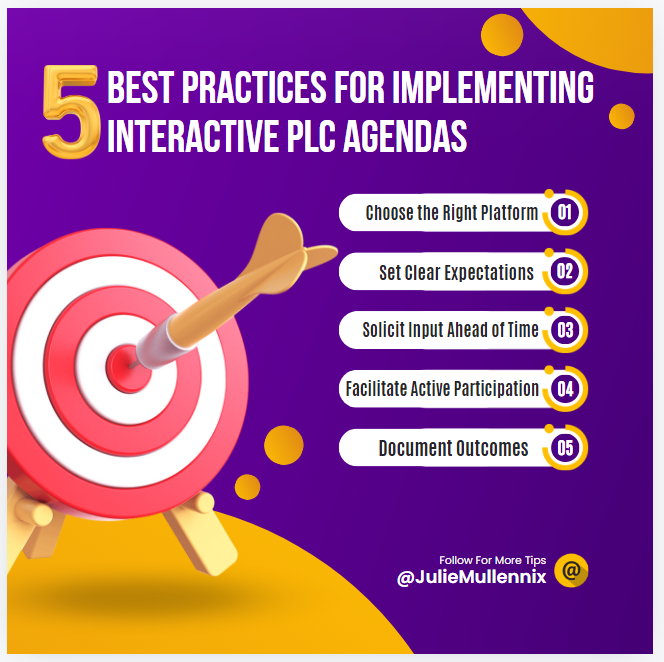Professional Learning Communities (PLCs) are an integral part of the educational landscape, fostering collaboration among educators to improve teaching practices and student outcomes. However, the effectiveness of PLCs can vary significantly based on how they are organized and run. One powerful tool to enhance collaboration during these sessions is the use of an interactive agenda. Discover how this dynamic tool can align instructional practices to be more student-centered, ensuring a focused approach on learning and addressing the four key questions of PLCs. By leveraging interactive agendas, educators can foster collaboration, enhance engagement, and ultimately improve student outcomes.
What is an Interactive Agenda?
An interactive agenda is a live, editable digital document that outlines the topics to be discussed during a meeting but also allows for real-time collaboration and input from all participants. Unlike traditional static agendas, which are typically prepared by a single person and followed rigidly, interactive agendas can be edited, commented on, and updated by everyone involved, fostering a more inclusive and engaging PLC environment.
Benefits of Using Interactive Agendas in PLCs
1. Enhanced Participation
Interactive agendas encourage all members to contribute both before and during the meeting. Facilitators can solicit input on agenda items ahead of time, ensuring that the topics covered are relevant and of interest to the group. During the meeting, participants can add comments and suggestions directly into the agenda, leading to richer discussions and more diverse viewpoints centered around student learning and outcomes.
2. Improved Organization
With an interactive agenda, teams can easily keep track of meeting notes, action items, and follow-up tasks. Most digital platforms that support interactive agendas, such as Google Docs or Microsoft Teams, offer features like real-time editing, version history, and task assignment, which help to maintain clarity and accountability.
3. Real-Time Collaboration
Interactive agendas allow for synchronous collaboration, meaning that all participants can engage with the content simultaneously. This real-time interaction can spark spontaneous brainstorming sessions and immediate feedback, making the meetings more dynamic and productive.
4. Increased Accountability
By documenting discussions and decisions within the interactive agenda, it becomes easier to track who is responsible for specific tasks and follow-up items. This transparency helps ensure that everyone is held accountable for their contributions and commitments, leading to more effective implementation of agreed-upon actions.
5. Accessibility and Inclusivity
Digital interactive agendas are easily accessible to all participants, regardless of their physical location. This is particularly beneficial for PLCs that include members from different schools or departments. Moreover, features like screen readers and text-to-speech can support participants with disabilities, making the meetings more inclusive.

Best Practices for Implementing Interactive Agendas
1. Choose the Right Platform
Select a digital tool that is user-friendly and supports real-time collaboration. Google Docs, Microsoft Teams, and Trello are popular options that offer robust features for creating and managing interactive agendas.
2. Set Clear Expectations
Ensure that all participants understand how to use the interactive agenda and what is expected of them. Provide guidelines on how to add items, make comments, and track tasks.
3. Solicit Input Ahead of Time
Invite participants to contribute to the agenda before the meeting. This can be done through a shared document or a survey. Early input ensures that the agenda reflects the group’s priorities, voice and interests.
4. Facilitate Active Participation
During the PLC session, encourage everyone to engage with the agenda. Use features like commenting, highlighting and inputting data to draw attention to key points that foster discussions centered around student-learning outcomes.
5. Document Outcomes
At the end of the meeting, summarize the key takeaways and action items within the interactive agenda. Assign tasks to specific individuals and set deadlines to ensure follow-through.
Interactive Agendas in Action
Interactive agendas are a powerful tool for enhancing collaboration and accountability in PLCs. By fostering real-time participation, improving organization, and increasing accountability, they can transform meetings into more productive and engaging experiences that align with the 4 Questions of PLCs and focus on student learning. As educators continue to seek ways to improve their practices and student outcomes, leveraging interactive agendas can be a game-changer for professional learning communities.
Join Us at TCEA 2025
Looking to level up your leadership and coaching skills? Join us at at the 2025 TCEA Convention & Exposition for more hands-on tips and tricks to take your team to the next level.

